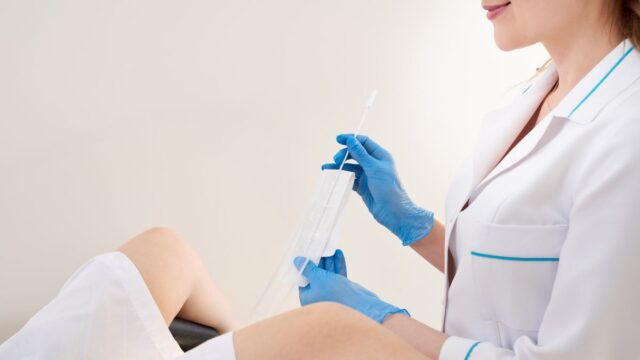“STD? Aise sab nahi bolte.” This is how we usually tend to treat all subjects that are considered taboo. Our society would want a newly married couple to give them “khushkhabari” as soon as they’ve returned from their honeymoon. Our culture of suppressing the need to discuss health conditions, especially those that are sexual and women-centric, is an impediment to spreading awareness about diseases like STDs for women.
Did you know?
There are around 376 million new transmissions of different types of STDs – syphilis, chlamydia, and gonorrhoea?
These are all common types of STDs, which we will read about further in this article.
4 Common Symptoms Of STD
Let’s briefly discuss what STDs is. Sexually Transmitted Diseases (STDs) are transmitted through vaginal, anal, or sexual contact. They cannot spread through physical touch, contrary to what many believe. Adding to this is a very important question – how do you know you have an STD? There are some common symptoms of STDs in females. These signs of STD in females are as below:
- Vaginal itching
- Rashes
- Unusual vaginal discharge
- Pain
Unfortunately, STDs often remain asymptomatic, that is, the symptoms don’t manifest themselves. And if left untreated, they can lead to fertility issues and also pose a high risk of developing cervical cancer.
5 Common Types Of STDs In Women & Their Signs, Causes, Diagnosis & Treatment
After reading about STDs and the common symptoms of STDs in females, let’s know more about the common types of symptoms of STDs in females. What are they? What are their common causes and risk factors attached to them, along with the treatment and diagnosis of these STDs?
1. Chlamydia
Chlamydia Is one of the most common STDs in women. The infection attacks the cervix, causing severe pain during intercourse.
Causes & Risk Factors
The most challenging aspect of diagnosing Chlamydia is the absence of symptoms in most cases. Hence, in such cases, they remain untreated. And if that happens, it may have an adverse effect on the fallopian tubes and also severe pelvic infections, gradually leading to infertility.
Signs & Symptoms
One of the very few STD chlamydia symptoms, if at all it manifests itself, is cervicitis. This health condition involves vaginal discharge and abdominal pain.
Diagnosis
Chlamydia can be diagnosed through invasive and non-invasive screening methods. The invasive method involves collecting a sample from the cervix using a speculum. On the other hand, non-invasive screening involves a collection of a urine sample or a vaginal swab.
Treatment
For the treatment of Chlamydia, antibiotics are used in most cases. Oral medication like azithromycin or doxycycline is usually prescribed.
2. Gonorrhoea
Gonorrhoea is a bacterial infection caused by the organism Neisseria gonorrhoeae that is transmitted by sexual contact. It is one of the oldest known sexually transmitted diseases. Research shows that most women with chlamydia will also be infected with other STDs as well.
Causes & Risk Factors
The bacterium that causes gonorrhoea requires very specific conditions for growth and reproduction. It thrives only on moist surfaces within the body like the vagina, and, more commonly, the cervix.
Signs & Symptoms
Gonorrhoea symptoms are as below:
- Burning during urination
- Frequent urination
- A yellowish vaginal discharge
- Redness and swelling of the genitals, and
- Vaginal itching or burning
Diagnosis
Most cases of gonorrhoea are tested by swabbing the infected area – be it the rectum, throat, or cervix. A sample is collected on a swab and tested through a medical procedure called “culture” for identifying the genetic material from the bacteria.
Treatment
Relevant injections and oral medications are known for treating gonorrhoea
Can be prescribed.
3. Syphilis
Syphilis is one of the oldest sexually transmitted diseases among women. The infection spreads and affects the moist, mucous-covered lining of the mouth or genitals. This results in a mild and painless ulcer known as a chancre.
Causes & Risk Factors
Syphilis is caused by a bacterial organism called a spirochete, also known as Treponema pallidum in scientific terms.
Signs & Symptoms
There are three stages of syphilis. Let us learn what the symptoms are in each stage.
Stage 1: This stage involves the formation of an ulcer.
Stage 2: Signs of STDs in females, The formation of ulcers in the earlier stage might resolve on its own, even without treatment. However, in some cases, this does not happen. Instead, the infection proceeds to the second stage, known as secondary syphilis. This occurs weeks to months after the primary stage and lasts from four to six weeks.
Stage 3: After secondary syphilis, some patients will continue to carry the infection without symptoms. This is the so-called latent stage of the infection. The prominent symptoms include:
- Abnormal bulging of the large vessel leaving the heart (the aorta), resulting in heart problems
- The development of large nodules (gummas) in various organs of the body
Diagnosis
Syphilis can be diagnosed by scraping the base of the ulcer and looking under a special type of microscope for the spirochetes. However, there is a high possibility that the spirochetes are rarely detected, the diagnosis is most often made based on the appearance of the ulcer.
Treatment
The treatment options for syphilis differ depending on the stage of the disease and the clinical diagnosis. The common penicillin injections have been very effective in treating both early and late-stage syphilis. Women who are infected during pregnancy can pass on the infection to the foetus through the placenta. Therefore, a regular checkup with the doctor is highly recommended in such cases.
4. Genital Herpes
Genital herpes, also commonly called “herpes”, is a viral infection by the herpes simplex virus, abbreviated as HSV. This is transmitted through intimate contact with the mucous-covered linings of the mouth or the vagina, or the genital skin. During intercourse, the virus makes its way into the linings or skin through microscopic tears.
Causes & Risk Factors
Genital herpes is caused only by direct person-to-person contact. It is believed that a majority of women with sexually transmitted diseases carry the herpes virus.
Signs & Symptoms
Once you are exposed to the herpes virus, there is a period that generally lasts 3 to 7 days before a lesion develops. At this time, there are no symptoms and the virus cannot be transmitted to others. An outbreak usually begins within two weeks of the initial infection and results in an itching or tingling sensation followed by redness of the skin.
Diagnosis
Herpes is diagnosed with a test polymerase chain reaction (PCR) to identify the genetic material of the virus. Rapid fluorescent antibody screening tests may be recommended to identify herpes.
Treatment
Although there is no known cure for herpes until today, there are treatments for STDs in females. There are oral medications – acyclovir, famciclovir, or valacyclovir that prevent the virus from multiplying and also restrict the span of the infection.
5. HPV
There are more than 40 types of HPV that are the cause of genital warts infecting the genital tract. These warts are primarily transmitted during sexual intercourse. The other types of HPV generally cause common warts elsewhere in the body.
Causes & Risk Factors
Cervical cancer and other anogenital cancers in women are caused mainly due to HPV.
Signs & Symptoms
HPV infection does not usually lead to the development of warts, cancers, or related symptoms. The majority of people infected with HPV have no symptoms or lesions at all.
Diagnosis
A typical appearance of a genital lesion will cause the physician to treat it without any further testing, especially among those who have had prior outbreaks of genital warts.
Treatment
There is no cure or treatment for STDs in females that can completely remove HPV infection. So, the only treatment involves removing the lesions caused by the virus. Also, even if the warts are removed from the body, it does not necessarily prevent the spread of the virus. Hence, genital warts frequently recur.
Preventive Measures Against STDs
The most important fact to remember about sexually transmitted infections is that all of them are preventable. However, the risks of these infections are often undermined. The use of condoms plays a vital role in reducing the risk of transmission of these infections. However, they do not prevent the transmission of many infections altogether.
Now that you have a fair knowledge of the most common types of STIs, their symptoms, risks, diagnosis, and treatment, it will be easier for you to be more conscious about preventing them. Since some of these infections do not manifest themselves, it is important that you undertake an STI panel test annually to ascertain whether you have been infected with the virus. Remember, the easier the diagnosis, the more effective will be its treatment.
Open up like never before and participate in conversations about beauty, entrepreneurship, mental health, menstrual & sexual health, and more. Desi women, join our community NOW!



